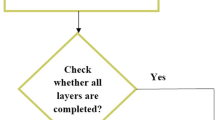Abstract
Surface hardness value is a commonly used indicator for describing the mechanical property of stereolithography parts. In order to investigate colorants how to influence the surface hardness of colorful resin component, a procedure is proposed to fabricate testing specimens based on color stereolithography technology in this study. Liquid photosensitive resin LPR2001 is mixed with two colorants (phthalocyanine blue and eosin powder) respectively before curing. The phthalocyanine blue powder is insoluble and only dispersive in the solid-liquid mixture which results in deposits. Therefore, surface modification is conducted to the phthalocyanine blue powder for improving wettability. By contrast, the eosin powder is dissoluble and does not cause any deposits in the liquid resin. Specimens are produced by laser curing colored resin and tested by MTSR Nano Indenter XP system. The change of hardness values is illustrated at certain mass percentages of colorant. Comparisons and discussions are carried out to explain the colorants’ effect. It is concluded that incorporating colorant to liquid resin results in decreasing the surface hardness of components. But sensibilization effect of the colorants also influences the curing process. Surface modification to the phthalocyanine blue powder is a feasible method to increase the hardness value of color stereolithography components. Dissolvable eosin has an approximate linear effect on surface hardness.
Similar content being viewed by others
References
Gibson I, Ming L W. Colour RP [J]. Rapid Prototyping Journal, 2001, 7(4): 212–216.
Junk S, Sämann-Sun J. Application of 3D colour printing for the rapid prototyping of functional models [C]//4th International Conference on Advanced Research in Virtual and Physical Prototyping. Leiria, Portugal: Taylor and Francis/Balkema, 2009: 677–680.
Ming L W, Gibson I. Specification of VRML in color rapid prototyping [J]. International Journal of CAD/CAM, 2002, 1(1): 1–9.
Wang Y, Ma Y, Gong H. Experimental research on color stereo lithography [C]//The 12th International Manufacturing Conference in China. Xi’an, China: Trans Tech Publication Inc., 2006: 58–61.
Gong H, Wang M, Wang Y. Color stereolithography based on time-pressure dispensing process [C]//Proceeding of the 2010 IEEE International Conference on Mechatronics and Automation. Xi’an, China: IEEE, 2010: 99–103.
Fu S, Zhang K, Zhhang M, et al. Encapsulated phthalocyanine blue pigment with polymerisable dispersant for inkjet printing inks [J]. Pigment and Resin Technology, 2012, 41(1): 3–8.
Sertel O, Kong J, Lozanski G, et al. Computerized microscopic image analysis of follicular lymphoma [C]//Proceedings of the SPIE — The International Society for Optical Engineering. San Diego, CA, USA: SPIE — The International Society for Optical Engineering, 2008: 691535–1-11.
Gibson I, Rosen D W, Stucker B. Additive manufacturing technologies: Rapid prototyping to direct digital manufacturing [M]. New York: Springer, 2009: 75–76.
Wu M, Zhao W, Tang Y, et al. A novel stereolithography technology with conventional UV light [J]. Rapid Prototyping Journal, 2001, 7(5): 268–274.
Zhang J, Xu Y, Huang P. Effect of cure cycle on temperature/degree of cure field and hardness for epoxy resin [J]. E-Polymers, 2009, 3(9): 534–541.
Zhu Ling. Effects of photo-initiator and pigment on curing speed of UV ink in ink-jet printing [J]. Dyestuffs and Coloration, 2004, 41(3): 158–160 (in Chinese).
Wang De-hai, Chen Xiao-fang. Effect of interfacial state between pigment and binder on the UV curing proficiency [J]. Journal of Radiation Research and Radiation Processing, 2004, 22(6): 344–348 (in Chinese).
Author information
Authors and Affiliations
Corresponding author
Additional information
Foundation item: the Specialized Research Fund for the Doctoral Program of Higher Education of China (No. 20112302120054) and the Fundamental Research Funds for Central Universities (No. HIT.NSRIF.201169)
Rights and permissions
About this article
Cite this article
Gong, Hj., Wang, Ml. & Wang, Y. Surface hardness evaluation of components made by color stereolithography. J. Shanghai Jiaotong Univ. (Sci.) 18, 738–741 (2013). https://doi.org/10.1007/s12204-013-1459-1
Received:
Published:
Issue Date:
DOI: https://doi.org/10.1007/s12204-013-1459-1




